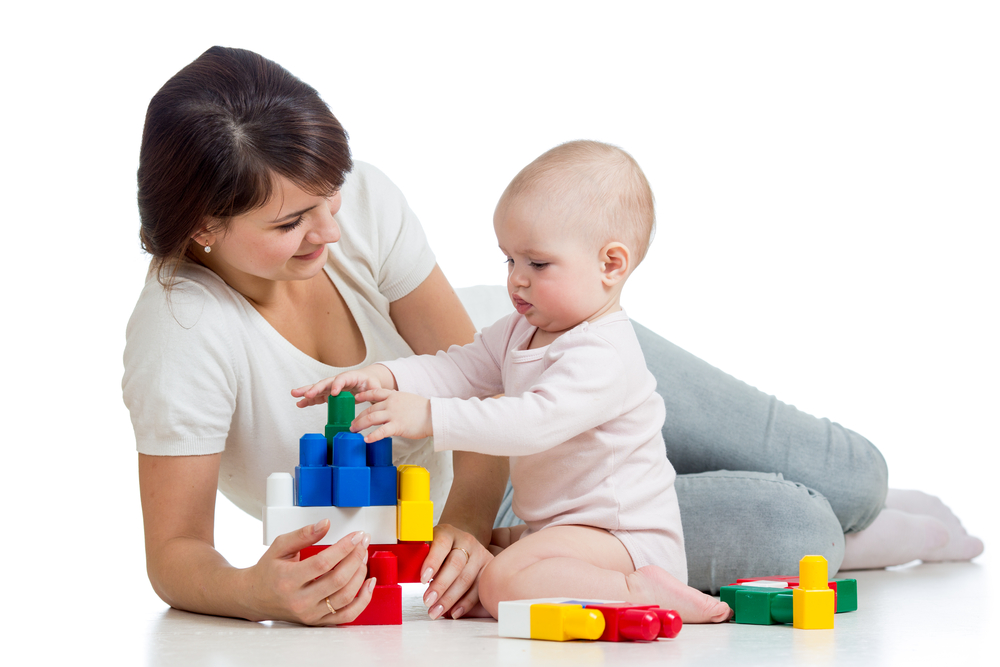9 play strategies guaranteed to get your toddler talking
Written by Carianne Vermeulen | Speech Therapist
Tags: PlaySpeech & LanguageStimulationToys
Play is absolutely vital to your child’s development and it is a life-long process that enhances development for children of all ages. Every time a baby or toddler engages in a (play) activity the nerve cells in the brain are stimulated and connections are made. This process influences every aspect of your baby’s development, including speech and language development.
In the early years, your child’s brain is like a sponge. Babies are keen to learn about the world around them and they soak up all the information and experiences they get. Through various types of play, toddlers learn to discover, create, and problem solve in a safe, caring environment.
As toddlers grow and mature, their play skills also change, allowing for the development of new skills that are more varied and complex. However, at any stage, parents play an important role in helping to facilitate growth of speech and language skills that are important for later social and learning experiences.
As children get older, they will enjoy more independent play time. To make the most of your precious playtime together, bear the following play strategies in mind to get your toddler talking:
1. Their level of interest
A toddler’s interest level often determines how engaged they become in a given activity. It is therefore important to become an observer of your toddler’s play and engage him/her in play activities that they find interesting.
Having a shared focus is important, because not only are you giving your child a point of reference when you talk about things, but your toddler is learning to listen and using attention skills.
These skills are vitally important for childre when they reache school-going age and the early years are the key years for developing these skills. The best way to develop these skills is to spend time with your toddler, talk and play and have a shared focus.
2. Your language level
Remember to keep your level of language simple and easy to understand. One of the biggest things to be aware of when using language around your toddler is the level and complexity of the language you use.
Think about age and how much language he/she uses. Your young toddler will generally understand more words than he/she uses in play. Assuming your toddler is developing along normal lines, consider where to pitch your language.
For instance, if your toddler is aged 2 years and 6 months and can follow a short instruction containing 2 key words, be mindful of this when you talk to him/her. Long sentences will generally not be understood.
If your toddler has difficulty understanding, just use key words, more intonation, and gesture, or point as you say the words.
Modelling language for your child also provides exposure to new vocabulary and correct grammar while speaking. Play is an excellent opportunity for your toddler to attach meaning to words and build vocabulary.
Providing accurate language input can include commenting about what you or your toddler is doing, adding a word or phrase to your toddler’s short phrases, exposing your toddler to synonyms, or by modelling the correct sentence structure. This will depend on the stage of language development of your toddler. Examples include the following: Toddler: “Ball” Parent: “Yes, big ball.” Toddler: “Ball” Parent: “Throw the ball.” Toddler: “Ball go’ed far.” Parent: “Yes, the ball rolled far.” Toddler: “Mom, that is a huge ball!” Parent: “You are right. It is enormous!”

3. Face your child at eye level and practice turn taking
Take the pacifier out and turn off the television while playing with your child. Establishing successful eye contact and turn-taking routines will facilitate social and communicative skill development in your toddler.
Turn-taking is a skill that can easily be promoted through play with children of any age. Offering a brief pause when it is your child’s turn will increase their initiation, communication and independence.
During play with young babies, you can also facilitate turn-taking by cooing, waiting for a response and then cooing back. With toddlers, you can take turns stacking blocks.
Further techniques to facilitate turn-taking include: using facial expressions, body language (e.g. making eye contact and waiting, gesturing for the child’s response), and asking questions.
Remember, repeat your toddler’s vocalizations, words and phrases to provide good and positive modelling.
4. Sing songs and nursery rhymes
Singing songs is a fun, interactive way for your child to learn language. Songs can include well-known children’s songs like “Twinkle, Twinkle Little Star” or can be made up to fit whatever you are doing at the time (e.g. cleaning up, eating a snack, playing in the yard or getting dressed).
Singing songs provides increased exposure to vocabulary through repetition and creates opportunities for turn-taking. Turn-taking can be accomplished by allowing your toddler to fill in key words in the songs.
Singing the songs slowly and singing them along with actions are ways to increase language acquisition. When music is paired with actions, children also have the opportunity to practice listening skills, following instructions, as well as motor skills (e.g. Hoky Pokey).
5. Read lots of books together
Books are filled with opportunities to facilitate language skills. While reading stories that are familiar to your toddler, you can develop speech, language and memory skills.
Expose your toddler to a variety of books and watch to see what books he/she prefers. By following your toddler’s lead, you will capture their attention.
Initially, you should read books with simple pictures and simple text. Consider board books, pop-up books, books with textures, and other interactive books. You can borrow books from the library as a “test run” prior to purchasing them.
Storytime is great for turn-taking. It is common for us to read stories to children with them sitting in our lap but is also a good idea to read stories face-to-face. When you are face-to-face with a child, they are able to observe your non-verbal communication (i.e. facial expression) and are more likely to take turns with the activity.
For toddlers, it is not necessary to start at the beginning of the book nor to read all the pages in the book. Your toddle may want to skip pages and just look at the pictures without reading the story. Use this as an opportunity to talk about the pictures. Ask your toddler questions and make comments about what you see.
At this age, the focus of book sharing should be to build the foundations for comprehension (e.g. vocabulary, sequencing, predicting) rather than addressing letter or word identification.
Your toddler may also enjoy being able to take part in the story-telling. By offering a brief pause before reading the last word in a sentence, he/she has the opportunity to fill in the anticipated word. You can take turns by reading one page and having your child “read” the next page. This technique works well with stories that have repetitive lines.

6. Play with open-ended toys (and ditch the battery-operated toys)
When looking for toys for your toddler, choose toys that provide open-ended play. You want toys where your toddler “does the doing” (e.g. building blocks) and not the toy.
Try to avoid toys with batteries as much as possible. It is ok to have a few toys with batteries (e.g. a car making a sound when driving, lights that flash when your baby puts the shape in the shape sorter, a toy vacuum, etc.), but make this the exception, and not the rule.
7. Don’t be concerned about gender
When choosing toys for your child, do not stick to gender-specific toys. Let your girls play with trucks and trains and boys play with toy kitchens and baby dolls.
8. Set up open-ended play schemes
Setting up toddlers with open-ended play schemes is a great way to help their language skills and introduce them to a wide variety of vocabulary and concepts.
For example, you can set up some train tracks with trains, cars on a track, some play food and pretend restaurant, etc. and let your toddler decide what he/she wants to play with or how he/she wants to use toys from different sets in his/sher playset.
If you do join in your child’s play, make sure that you do not try to take it over and force incorporation of your ultimate learning objectives into the play. Structured adult-led activities have their time and place but remember to also allow for time for your toddler to control and decide his/her own play.
9. Take a step back and feed in language
As your toddler gets older and engages in more independent play, you can enhance their development of language by sometimes taking a step back during play and letting them take the lead.
This gives your toddler the control of his/her environment and builds confidence. Although you are still involved in the play, you are not dictating what is happening. However, you can still be feeding language into the play as it is happening.
Lastly, don’t feel that you need to fill any gaps of silence… just watch, listen, add language where appropriate and listen as the magic happens.
Share this
- 0
- 0
Related Posts
Have you tried the Nubabi Free Trial?
Get unlimited access to Your Parenting Toolkit for 2 weeks for free!
Track, Boost, Explore and Capture your child's growth and development.
Available on both mobile and web.





